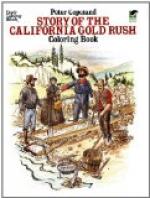In this peninsula of Lower California fifteen Missions, or settlements, each having a church, were founded by Padres of the Jesuits. But later the Jesuits were ordered out of the country, and their Missions turned over to the Franciscan order of Mexico.
With the coming of the Franciscans a new period of California’s history began. Spain wished to settle Alta California, or that region north of the peninsula, and Father Serra, the head and leader of these Franciscans, was chosen to begin this work.
How he did this, and how he and his followers founded the California Missions you will read in the story of that time.
THE STORY OF THE MISSIONS AND OF FATHER SERRA
The old Missions of California are landmarks that remind us of Father Serra and his band of faithful workers. There were twenty-one of their beautiful churches, and though some are ruined and neglected, others like the Mission Dolores of San Francisco and the Santa Barbara and Monterey buildings are still in excellent condition. From San Diego to San Francisco these Missions were located, about thirty miles apart, and so well were the sites chosen that the finest cities of the state have grown round the old churches.
Father Junipero Serra was the president and leader of the Franciscan missionaries and the founder of the Missions. He had been brought up in Spain, and had dreamed from his boyhood of going to the New World, as the Spanish called America, to tell the savages how to be Christians. He began his work as a missionary in Mexico and there labored faithfully among the Indians for nearly twenty years. But as his greatest wish was to preach to those in unknown places he was glad to be chosen to explore Alta or Upper California.
Marching by land from Loreto, a Mission of Lower California, Father Serra, with Governor Portola and his soldiers, reached San Diego in 1769. Here he planted the first Mission on California ground. The church was a rude arbor of boughs, and the bells were hung in an oak tree. Father Serra rang the bells himself, and called loudly to the wondering Indians to come to the Holy Church and hear about Christ. But the natives were suspicious and not ready to listen to the good man’s teachings, and several times they attacked the newcomers. Finally, after six years, they burnt the church and killed one of the missionaries. But later on there was peace, and the priests, or Padres as they were called, taught the Indians to raise corn and wheat, and to plant olive orchards and fig trees, and grapes for wine. They built a new church and round it the huts, or cabins, of the Indians, the storehouses, and the Padre’s dwelling. In the early morning the bells called every member of the Mission family to a church service. After a breakfast of corn and beans they spent the morning in outdoor work or in building. At noon either mutton or beef was served with corn and beans, and at two o’clock work began again, to last till evening service. A supper of corn-meal mush was the Indians’ favorite meal. They had many holidays, when their amusements were dancing, bull-fighting, or cock-fighting.




